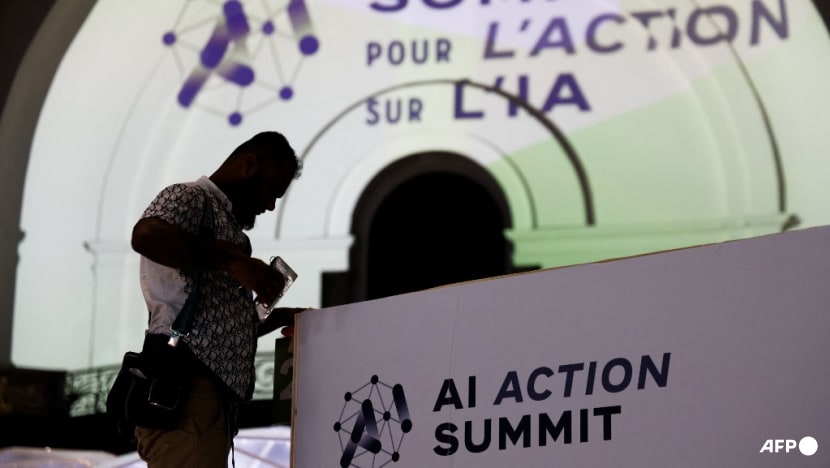Commentary: AI and the edge of possibilities
There’s potential for AI to address many, if not all, of the world’s most pressing challenges, says the World Economic Forum’s Cathy Li.

An employee installs a sign during the Artificial Intelligence (AI) Action Summit, at the Grand Palais, in Paris, on Feb 10, 2025. (Photo: AFP/Ludovic Marin)

This audio is generated by an AI tool.
GENEVA: In a lab in Singapore, an AI algorithm accelerates cancer detection, helping doctors pinpoint malignant cells with unprecedented speed and accuracy. On a farm in Kenya, sensors powered by AI analyse soil conditions in real time, guiding farmers toward precision irrigation that boosts crop yields while conserving water. Meanwhile, in the Arctic, machine learning models process satellite imagery to track ice sheet changes, giving scientists an early warning system for rising sea levels.
These AI breakthroughs tackle some of the world’s most pressing challenges. Yet conversations about AI remain narrow, consumed by debate over chatbots and virtual assistants, rather than its deeper potential to reshape entire industries and societies.
At this month’s AI Action Summit in Paris, we saw world leaders jostling for AI supremacy, with talk of investments that keep piling up.
Lost in the media hype is analysis of the concrete action on how to use AI where it matters most - in solving global challenges like climate change and healthcare, which exceed human capacity alone. While the technology exists to address many - perhaps all - of these challenges, its potential is not being explored.
In essence, current efforts are focused on relatively small-scale solutions rather than moon shots. This is why we need to learn to embrace, democratise and use AI.
SHORT-SIGHTED THINKING
As humans, we have a natural tendency to overestimate the effects of technology in the short term, while being blind to their much more profound long-term impact. As a result, our focus is currently narrow and we’re ignoring the potential of AI to transform the models and systems on which modern-day life runs.
Currently, just 16 per cent of companies consider themselves prepared for AI-driven reinvention, while 74 per cent face critical barriers to scaling AI solutions. This is a problem when reinvention through systems transformation is the way forward.
What does system transformation look like? In healthcare, it means automating administrative tasks to free up clinicians' time, improving diagnoses through AI-enhanced decision-making, accelerating drug development, and personalising treatment for individuals.
It does not mean replacing key workers but supporting them, allowing them to focus on the most meaningful aspects of their roles.
To achieve this requires powerful forces - enablers - such as the need to demonstrate returns to ensure long-term investment, the realignment of policy as well as public-private priorities, prioritising shared infrastructure and data pools, equipping leaders with the skills so they can make informed decisions about technology, cybersecurity and building trust to detect AI-related risks.
Systems change is complex and interconnected with the broader economy, often facing resistance from those favouring the status quo. Key challenges include misalignment between technical experts and policymakers and fragmented regulation.
While disruptive at first, systems change ultimately leads to more efficient and effective structures, despite the challenges of implementation in already overburdened frameworks. It’s a sound theory, but how do we get there?
MOVING BEYOND COST AND EFFICIENCY GAINS
First, AI’s potential - its real potential - must be embraced. This can be achieved through multistakeholder actions, putting the best outcomes for society as the priority and collectively figuring out what needs to change. To truly raise ambition and be able to dream of what couldn’t be done before, collaboration is essential across public-private, industry, regional and individual. This will address hurdles such as finding means to facilitate change, the cost of training AI or sharing data in a safe and secure way.
Second, AI must be democratised. Such a powerful technology cannot be the remit of countries and regions that already have ready access to AI resources. Failing to democratise AI risks widening the digital divide, making it impossible to govern such a ubiquitous technology. Without proper governance, the risks of misuse will be far greater. Cognisant of this, The World Economic Forum created the AI Governance Alliance in 2023, to promote a holistic approach towards creating more equitable, responsible AI societies.
Third, confidence in using AI. In part, this will come out of realising its potential and making it both relevant to people’s lives and part of a “natural” way of working and living. Early mobile phones were highly priced, large, clunky devices, little fit for purpose, but with better design, improved technology and production at scale have become a largely indispensable part of life.
In this respect, AI model and application developers need to develop and deploy technologies in a responsible and sustainable way. This will help gain public trust, something that is currently not a given.
AI is at the stage where the blueprint for intelligent economies is being shaped. Integrating AI with other emerging technologies, such as biotechnology, quantum computing, robotics, spatial intelligence and more, will create the foundations for future innovations.
Ultimately, technology can’t help solve human problems unless humans let it do so. With the right approach, true transformation is possible.
Cathy Li is Head of AI, Data and Metaverse, and Deputy Head of the Centre for the Fourth Industrial Revolution at the World Economic Forum.

















